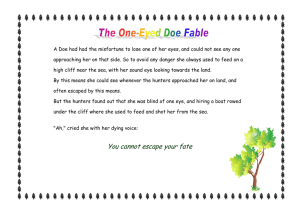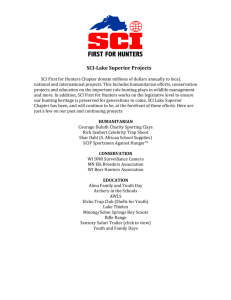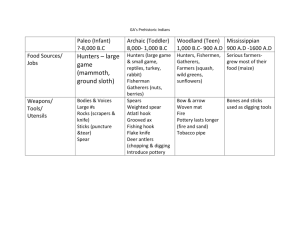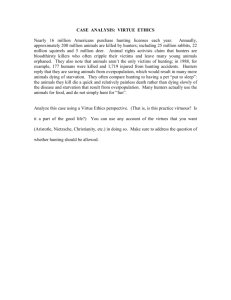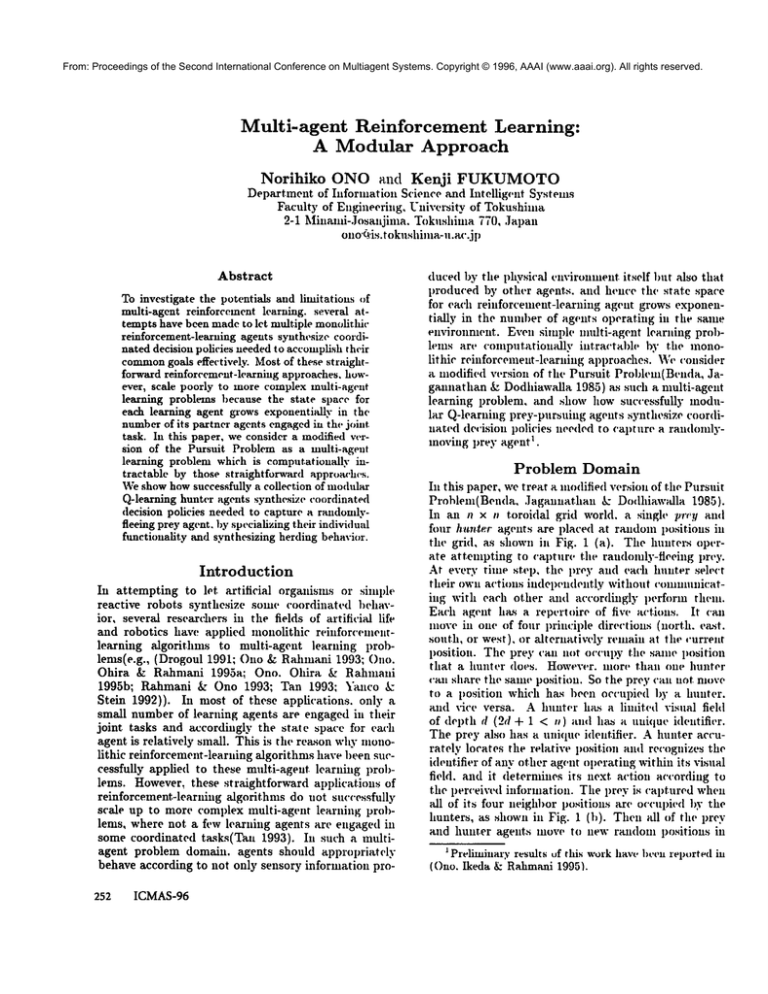
From: Proceedings of the Second International Conference on Multiagent Systems. Copyright © 1996, AAAI (www.aaai.org). All rights reserved.
Multi-agent
Reinforcement
Learning:
A Modular
Approach
Norihiko
ONe and
Kenji
FUKUMOTO
Department of Information Science ,’rod Intelligent Systems
Faculty of Engineering, University of Tokushima
2-1 Minanli-Josanjinla. Tokusllima 770, Japan
ono’~fis.t okushinla-u.ac.jl~
Abstract
To investigate tile potentials and limitations of
multi-agent reinforcement learning, several attempts have been madeto let multiple monolithic
reinforcement-learning agents synthesize coordinated decision policies neededto accomplishtheir
common
goals effectively. Mostof these straightforward reinforcement-learning approaches, howe~-er, scale poorly to more complexmulti-agent
learning problems because the state space for
each learning agent grows exponenti~dly in the
number
of its partner agents engagedin the joint
task. In this paper, we consider a modifiedw~rsion of the Pursuit Problem as a multi-agent
learning problem which is computationally intractable by those straightforward approaches.
Weshowhowsuccessfully a collection of nmdular
Q-learning hunter agents synthesize coordinated
decision policies needed to capture a randomlyfleeing prey agent, by specializing their individual
fimctionality and synthesizing herding behavior.
Introduction
In attempting to let artifcial
organisms or simple
reactive robots synthesize some coordinated behavior, several researchers in the felds of artifici~d life
and robotics have applied nmnolithic reinforcementlearning algorithn~s to multi-agent learning problems(e.g., (Drogoul 1991; One & Rahmani 1993; One.
Ohira & R’ahmani 1995a; One. Ohira & Rahmani
1995b; Rahmani & One 1993; Tan 1993; Yahoo &
Stein 1992)). In most of these applications, only
small number of learning agents are engaged in their
joint, tasks and accordingly the state space for eacll
agent, is relatively small. This is the reason whynmnolithic reinforcement-learning algorithms have been successfully applied to these multi-agent learning problems. However, these straightforward api)lications of
reinforcement-learning "algorithms do uot successfnlly
scale up to more coml)lex multi-agent learning problems, where not a few learning agents are engaged in
some coordinated tasks(Tan 1993). In such a nmltiagent problem domain, agents should appropriately
behave according to not only sensory information pro252
ICMAS-96
duced by the l)hysical environment itself but also that
produced by other agents, and hence th(’ state space
for each reinforcement-learning agent grows exponenti,-dly in the numl)er of agents operating in the same
environnwnt. Even simph, nmlti-agent learning probh,ms are (’ontputation~dly intractable by the monolithic reinforcement-learning al)proaches. We,’onsider
a modified version of the Pursuit Probh’nl(Benda, Jagannathan & Dodhiawalla 1985) as such a nmlti-agent
learning problem, and show how successfully modular Q-learning prey-pursuing agents synthesize coordinated decision l)oli(’ies needed to capture a randomly1moving
.
prey agent
Problem
Domain
In this paper, we treat a modified version of the Pursuit
Problem(Benda, Jagannathan &: Do,lhiaw~dla 1985).
In an n x r~ toroidal grid world, a single p’r~T and
four hunter agents are placed at ravdoml,t)sitiotts
in
the grid, as shown in Fig. 1 (a). The hunters operate attempting to cal)ture the raudomly-fleeing prey.
At every time step, the prey and each hunter seh,(’t
their ownactions in(lel)endelltly without ,’omnmnicating witll each other and accordingly perform them.
Each agent ha.s a repcrtoire of five actions. It can
movein one of four l)rim:il)le directions (north. e~st.
south, or west), or alterlmtively remain at the current
l)osition. The prey can not oc(’Ul)V the same imsition
that a hunter does. Howew.r. nlore than one hunter
can share the same position. So the prey can not nmve
to a position which has been occupied by a hunter.
and vice versa. A hunter has a limit(’d visual fiehl
of del)th d (2d + 1 < el) and ha.~ a unique identifier.
The prey also has a unique identifier. A hunter accurately locates the relative position and recognizes the
identifier of any other ag~.nt operating within its visual
field, and it deternlines its next action according to
the perceived infi)rmation. The 1)rey is captured wh(.n
all of its four neighbor positions are oc(’ul)ied by the
hunters, as shown in Fig. 1 (b). Then ~dl of the prey
and hunter agents mow, to new random positions in
1 Preliminaryresults tJf this workhave beell reported in
(One. Ikeda & Rahmani19951.
From: Proceedings of the Second International Conference on Multiagent Systems. Copyright © 1996, AAAI (www.aaai.org). All rights reserved.
--
Reinforcement
IEnvironRletlt~
Signa~l
&
HunterAgenti
(a) Aninitial state.
Aclion
"I
I
(b) A goalstate.
Figure 1: The pursuit problem. Four hunters and a
prey axe indicated by white and black circles, respectivel}: Each hunter is assigned an identifier (1,2,3. or
4) which is visible to the other hunters. A hunter is
able to accurately recognize the relative position and
the identifier of any other agent in its visual field of
depth d. In the figure, when d = 2, the visual field
of the hunter 1 is indicated by a shaded square in (a).
The relative position of the prey to the hunter 1 is
(-1,-2) in this initial configuration.
the grid world mid the next trial starts. The ultimate
goal for the hunters is to capture the prey as frequently
as possible.
This problem has been treated as a canonical problem in the field of distributed artificial intelligence
(DAI), but never as a multi-agent reinforcementlearning problem. Researchers in DAI have attempted
to suggest some coordinated strategies, based on their
proposed distributed problem solving principles, and
have evaluated the performaxwe(e.g., (Gasser et al.
1989; Levy & Rosensehein 1991)). In this paper,
attempt to let reinforcement-leaxning hunter agents
spontaneously synthesize some coordinated strategies.
As a basic learning algorithm, we have chosen to employ Q-leaxning. However, the straightforward application of monolithic Q-leaxning to this kind of multiagent learning problems brings about the problem of
combinatorial explosion in the state space. Since nmltiple learning agents, each observing its paxtners’ behavior, have to jointly perform a coordinated task, the
state space for each learning agent grows exponentially
in the numberof its partners. For example, let us represent the state of a hunter agent by a combination of
the relative positions of other agents, where the positions are represented ! V some unique symbols when
they are not located within the hunter’s visual field.
Although there are only a small number of collaborative agents involved, the size of state space for a hunter.
((2d+ 2 + 1) 4, iSenormous even when the visual fiel d
depth d is small: e.g., at. d = 2 and d = 3, it mnounts
to 456, 976 and 6, 250, 000 respectively.
For this reason, we have decided to construct each
hunter agent by a variant of Whitehead’s modular Qlearning architecture(Whitehead et at. 1993) as shown
in Fig. 2. This architecture consists of three learning-
......................................................................
Figure 2: Modular architecture for a hunter agent.
Leaxning-Module it only locates the partner i~ and
the prc~: and does not concern any other partners’ positions.
modules attd a single mediator-module. Each learningmodule focuses on specific attributes of the current
state azld performs Q-leaxning. Morespecifically, each
module only observes the relative position of the prey
aml that of a partner associated with some specific
identifier and ignores any information concerning the
other partners. Its state is represented by a combination of these relative positions and its size equals
((2d + "~ + 1) 2. This si ze of state spa ce is tra ctable
by monolithic Q-leaxning algorithm so long as d is relatively small. On the other hand, a mediator-module,
without leaxning, combines leaxning-modules’ decision
policies using a simple heuristic decision procedure and
detennines a final decision by the corresponding agent.
In our preliminary experiments, the mediator-module
selects the following axtion:
arg inax
aE A
3
E ~ik (d’ik
~ a)
/¢=1
where Q;~ denotes the action-value function implemented by the learning-module
ik. This corresponds to what is called 9reatest mass merging strategy(Whiteheadet al. 1993). Intuitively, this is a selection by majority amongartious proposed by individual
2.
leaxning-modules
Our modular Q-learning architecture is based on the
original one proposed in (Whitehead et al. 1993), but
they are not identical. The architecture in (Whitehead
2 Previouslyweconsideredanother variant of the pursuit
problemwhereeach hunter’s identifier is invi,~ible to mty
other agents, rO,"e used yet another modular approach to
the problem, and the preliminary results are reported in
(Ono. Fukumoto& Ikeda 1996).
Ono
253
From: Proceedings
of the
Second
International
Conference
Multiagent Systems. Copyright © 1996, AAAI (www.aaai.org). All rights reserved.
et al. 1993)
was
particularly
designed
for onconstruct-
ing a single reactive planner pursuing a fixed set of
dynamicMly-activated multil)le gems. It was primarily
employed for reducing the planner’s enorlnous state
space caused by the existence of multil)le goals. Here.
our architecture is designed for reducing each ~g,mt’s
intrax’tably enornmusstate space caused by tile existence of its partners jointly working in the same enviromnent. Note Mso that MI the learning-modules, in
our modular architecture, are Mwavsactiw, and participate in the reillh)rceinent-learning task unlike in the
Whitehead’s ease.
15oo - ----~
"~ 14001300 1200~. 11(X)
~. 10oo-
900r~ 800-
70o600500-
400~" 300-
i ............ .k.
254 ICMAS-96
,
5000
0
1.104
Trials
,
I fi.104
,
’l
2.10
(a) I0 byIOtoroida]environment.
Simulation Results
Our simulation run consists of a series of trials, each of
which begins with a single prey and four hunter agents
placed at random positions, and ends when the prey
is captured. A trim is aborted when the prey is not
captured within 1,500 time steps. Upon capturing the
pre3; individual hunters immediately receive a reward
of 1.0, and accordingly ",dl of its constituent learningmodules uniformly receive the same reward regardh.ss
of what actions they have just proposed. Our hunters
receive a reward of -0.1 ill any other case. The learning rate c~’ and discount factor 3 are set to 0.1 and
(}.9, respectiw,ly, hlitiM Q-vahles for individual stateaztion pairs are randomlyselected fi’onl the intet’x~M
[0.01,0.1].
The results of our simulation runs are shown in
Fig. 3. The solkl curves in this figure indicate the
performance by the umdular Q-learning hunters. At
init.ial trials, the hunters can not capture the prey effectively, lint shortly they start ilnproving their perfornlan(’e
draznatieall3: EventuMlythey colne to steadily
accomplish their task at every trim in any of our silnulation runs. The meanings of dashed curves will be
explained later.
’re set’ the efficacy ,)f our nlodular Q-learning approach compared with a strMghtforward monolithic
version, we tried to soh’e the pursuit problent using
a monolithic Q-learning approach. However. it turned
out to be difficult to implrnmnt each hunter by a monolithic Q-learning even when each hunter’s visual field
depth is small, say 3. So we have tO set the visual
field depth re 2 or 1 in order to show the monolithic
Q-learning hunters’ learning performance. Ill Fig. 4.
the performance by tile intplemented monolithic Qlearning hunters and that by the modular Q-h’arning
hunters are shown. It may be possible to inlprove
the monolithic Q-learning hunters" performance by flit(,
tuning of the learning parameters, but limited colnputational experience showedthat any significant, ilnprovenleilt is difficult.
~A:e have supposed that the prey selects its avrions
randomly. What will happen if the prey arteinpts to
escape from the located hunters? It is easy to let such
a prey totally outsmart our learning hunters, if it ha.s
the s&nze visnMfield depth as that of a hunter. For ex-
Modular
Q-learning
Hunters
- ........ Manually-Programmed
Hunters
1500
1400
_"
~
MedularO-leaming
Hunters
Manually-Programmed
Httatm’s
13oo
-
i
1200
1100 -
~ 7oo
lu
...o..~~
0 I
0
.........
I
I
5000
1.104
Trials
I
1.5.104
I
2.104
(b} 20 by 20torodial environment.
1500- ¯
o) 1400¯~
¯
=
l- 1300
12001100¯
1000-
"%
.........
Manually-Programmed
Huntem
~- ~0I--
,~-
~
’~
20o10110 1
0
-I
5000
I
1.104
I
1.5"104
I
2"104
Trials
(c) 30by 30tort)dialenvironment.
Figure 3: Perfln’mance of nmdular Q-learning hunter
agents.
Four hunters, ea(’h with a fixed visual
field depth 3. are operating together ill environments
with various dimensions. Solid curw,s indicate the
performance by ntodular Q-learning hunters, while
dashed curves indicate the l)erfornlance by maznzallylwogramlned huztters, which as explMned later, attempt re independently locate the prey I) 3" nmvingrandomly aztd then behave ill all optinlM way as soon as
locating it. Each curw’ is all average over 25 simulation runs. During the course of dramatically improving their perh)rmance, tit,. h’arning hunters are specializing their individual functionality as explain below. Note that the larger tit(, environnlent, tit(, mort,
clearly the learning hunt.,rs outl)erforln the ni~tnuMly1)rogrammed ones. The learning hunters outperfornl
tile l)rogrammedones tmdnly by synthesizing a kind of
herdiug I)ehavior as illustrated below.
From: Proceedings of the Second International Conference on Multiagent Systems. Copyright © 1996, AAAI (www.aaai.org). All rights reserved.
1500- %.
1400 ~. 1300-
-- Monolithic Q-learning Hunters
- ........ ModularQ-learningHunlers
1500
"~ 140013001£001100 -
......... 10X10Grid
.................
20x20Grid
30x30Gdd
1000-:
gO0-:
800-:
~ ~-:
~~,,~,,,~~_
500-:
In-- - "1~. ......... . ...... I- .................................
s1"10
0
5¢’104
Tna|s
500-
i
-I ................. ,
s2"10
15"105
Figure 4: Performance of monolithic Q-learning hunter
agents. A typical performance ~" monolithic Qlearning hunters is shownas well as that by tile modular Q-learning ones. In either case, each hunter’s visual
field depth equals 2 and a 10 x 10 environment is employed. The same learning rate, discount factor, and
Q-~due initialization
scheme as those described above
are employed here.
ample, if the prey behaves randomly when no hunter
is located, and otherwise it select.~ its actions so as to
maximize the total sum of Manhattan-distances to the
locatedhunters,
thenourlearning
hunterscannever
capture
thepre~:Usually,
inthiscasethepreycanescapefromthelocated
hunters
w~ryeasily,
andaccordinglyit is almostimpossible
forourlearning
hunters
togetthefirstpositive
reward.
However,
if theprey’s
visual
fiehlisshallower
than
thatof thelearning
hunters,
it is possible
to letthe
learning
hunters
synthesize
effective
coordinated
behaviorto captureit,evenwhenthepreymovesusing
themovingstrategy
mentioned
above.Figure5 shows
thetypical
results
of simulation
runswheretheprey
andeachhunterhavea visualfielddepthof 2 and3,
respectively.
In thesecases,
asshownin thefigure,
the
learning
hunters
synthesized
somecoordinated
behaviorwhichallows
themto steadily
capture
thepre~:
Synthesized Coordinated Behavior
Our modular Q-learning hunter agents exhibited two
kinds of collective behavior, namely, herding and
functionality-specialization.
During the course of
dramatically improving their performance, individual
hunters are specializing their functionality. To capture the prey, individual hunters have to exclusively
occupy one of four positions surrounding it. Let us
call these positions capture positions of corresponding
hunters. Eventually. our modular Q-learning hunters
attempt to improve their pursuit performance by completely fixing their individual capture positions, i.e.,
by specializing their functionality. Figure 6 illustrates
howsuch a functionally--specialization is typically developed among hunters where a 20 x 20 environlnent
is used. Each of these four 3D bar graphs shows a
200’1~ -I
0
2.104
4"104
6’,,104
Tdzds
8.10 4
1.10#
Figure 5: Performance of learning hunters pursuing all
escaping prey. In any of these three cases, the hunters
azld the prey have a visual field depth of 3 and 2, respectively.
Figure 6: Typical specialization
process by hunters.
transition of the probability distribution over capture
positions (indicated by relative directions to the prey)
taken by the corresponding hunter. At initial 2,900
trials, hunters have not fixed their own capture positions, but after trial 3.000, they have chosen their
own capture positions and during this change in their
behavioral patterns, their overall performance was dramaticMly improved.
Besides specializing their f, nctionality, our hunters
obtain a kind of herding behavior. Even if establishing
the above-mentioned static role-assignlnent,
hunters
can not always accomplish the capturing task effectively until they have obtained an effective way of collectively locating the prey: since each of them can only
observe a limited portion of the grid world. To see
this. we manually-programmed a set of four hunters.
Weassigned individually these hunters’ capture positions in advance, and then let them (i) attempt
Ono
255
From: Proceedings of the Second International Conference on Multiagent Systems. Copyright © 1996, AAAI (www.aaai.org). All rights reserved.
independently locate the prey by nmving ral,domly
and (ii) reach tl,eir capture positions ill a t)robabilistitally optimal way as soon as locating it. Tile dashed
curves in Fig. 3 show the performance by the programmedhunters. Note that the larger environment.
the more clearly our learning hunters outperform tl,t.se
manually-programmed hul,ters.
Our learning hunters do not attempt to locate the
prey independently, because it is not an effe~’tive way
even when the prey nmves randomly. Instrad tl,ey locate it in a coordinated manner. Once having locatrd
a partner, a lmnter attempts to keep the partner in
sight so long as the prey has not. been loc~tt.ed and
thereby it attempts to make a herd together with a
partner. By herding in this way hunters can olmrate
as each ot.her’s (,yes aml accordingly COnlpensatetheir
limited perceptual capabilities. However.tl,eir bet,avior suddenly changes once one of herding nmmbershas
happened to locate tl,e prey. The memberquickly attempts to reach its capture position and the otl,er ones
follow it and accordingly are likely to locate the prey.
Whenall of hunters have located the prey, they cat,
easily capture it.
Typically, the prey capturing process by our nmdular Q-learning hunters consists of two phases: (i)
collective search phase where all of hunters attempted
to identify the, prey’s position by configuring a herd,
and (ii) surrounding ph ase where ea ch hu nter ha ving identified the prey’s position attempts to reach its
fixed capture position in all effective way.
To illustrate tl,is coordi,mted behavior, a typiral
prey capturing process by our learning hunters is extracted in Fig. 7. The hu,tters have alreaxly experienced some 10, 000 trials in a 20 x 20 toroidal euvironment. The hunters" visual field depth is 3 and tl, e prey
moves randomly
In this specific trial, at an initial time step of 5, two
small groups of hunters are formed, and shortly they
are mergedinto a single large: group at time step 18.
Then the resulting group movein a consistent direction
to collectively searcl, the prey
At. time step 72, the hunter 3 happens to locate the
prey within its visual field and starts reaching its own
capture position. At this point, the others have not
located the prey, but they still attempt to move in a
herd. As a result, all the hunters succeed in locating the prey at time step 76, and are attempting to
reach their owncapture positions effectively. Finally
at time step 81. the hunters accomplish their common
goal successfully.
So faa" we have supposed that every hunter has the
same visual field uniformly. There is no best one
amongthe 24 possible specializations, and any of them
may be developed eventually by the learning hunters.
Thus, we can not foresee which specialization will be
eventually developed by the learning hunters prior to
the simulation run.
What will happen if the hunters have nonuniform
256
ICMAS-96
!: : i!::: il :
¯
i ¯
.
:
I ..
~...
. ¯ ~¯ ¯ . :
!3[
....
.
!.
[!
,
.!::
. : .
. .
¯:
-
.
........
......
:
: . .
.
! -.
! ¯
¯
: . ..;
¯.
.
.....
j
~_..
,.
: .....
-
"i
....
i "’~’"
¯ ’ . . . . "
. .....
.
. ¯ . :
¯ . . .. ¯
: .......
: .
: ; ¯ :
:
: .....
:
i
¯
....
time step = 18
~:"
::’"
¯
!:i::.
¯
i if:.
....
. ..
"
ii
!
.
..’
~
time step = 42
i~: "
!:i::i
i2~.i:i.....~
..:~: " ....
I:.
¯
.
.
.
: ..... .................
~
I,~’’.
.:..
i is!
’.U
!..
: . : .....
.........
time step = 39
!’
¯
: : - . .
.....
. ¯
.......
: .-.
: .....
":.’"
’ ¯ ¯
,.
.
....
" ":’
: ....
il.
":’i’"
ii.....
:. .
;, : ~.
" " ~
" : ......." " " : i¯ " " ..
.. ...
:
:.:..
! ....
....
..,~
]
:: O.""~. .ii ....
:. .....
ii
time step = 35
......
!~."i
.;: !.. ’
~..
::
i . ii::i?:::!:
. . .
. : .....
.......:
¯. . i .
. . .
i
iiii..}.! i!.ii? i:
....
i
......
:i
.....
time step = 17
::!2 + ::’’:
...
i¯
IQ’
;! ..........
...
~
¯
:
¯
""
: """ :
time step = 5
i
I
. :
i~:.. .!2!
:
¯ ~ ¯ t - : - . : ¯ ¯
¯ ¯ : ¯ ¯
; .
i . : ....
. . ....
:
....
.....
. .
¯ . . . : . . . ¯
QI::::.
) ¯ : ’’
.........
........
.......
: .....
i
.....
~ !~: .:
.......
:
. .....
¯ .....
...
..................
! :: i!i
1
i,-;.:.,!
: ::i
......
.:
: ............
.........
....
time step = 72
time step = 73
i ...................
I ’:: :
i : ::,
..i’
"iiii:
: ~1:’i
......
:::..:1!
..ii...:i
. . . ¯
. .
ii
.....
"
i..ili
~!
"
!i: :! :!!....... ..............
.....
iii
::"
. ....
! .......
; ..:.....
" : : ........
i!:’
,.
.........
! ....
¯ ::.
...
~
time step = 76
~ ....
...............
....
.: . . .
:
’
~ .....
.
:
¯ . . : ,
: .......
~ ..
time step = 81
Figure 7: Typical pursuit process by hunters.
From: Proceedings of the Second International Conference on Multiagent Systems. Copyright © 1996, AAAI (www.aaai.org). All rights reserved.
Figure8: Fourhunteragentswithnonuniform
visual
fields.
A hunter
is indicated
by a whitecircle,
whose
visual
fieldis depicted
by a shaded
rectangle
surroundingit.At eachsimulation
run,thesehunters
quickly
specialize
theirfunctionality
andeventually
tlteycome
to capture
theprey,indicated
by a blazkcircle,
from
thedirection
indicated
by theircorresponding
arrows.
visual fields? Are our learning hunters able to steadily
identify an appropriate one? Weconsider one of the
most interesting cases where the learlfing lmnters have
different visual fields as shownin Fig. 8. In this case,
our modular Q-learning hunters developed the same
specialization very quickly at ever), sinmlation run we
performed. A typical specialization
process by the
hunters is depicted in Fig. 9. Note that they agreed
on the eventual specialization much more quickly than
the hunters with uniform visual fiehts.
Synthesis
of Coordinated
Behavior
Multi-agent reinforcemel~t-learnivg is a difficult problem, especially when some forms of joint operation are
needed for the agents. We do not say m~r umdular
reinforcement-learning approach is generally applicable to any multi-agent problem solving. The successful results showa above strongly rely on the attrihutes
of the problem domain and our learning scheme. To
suggest this, we explain below how the learning solves
our pursuit problem.
Although it might sound strange, our learning
hunters acquire the above-mentioned herding behavior
first and then specialize their individual function’~lity.
Our hunters learn to makea herd even at initi~ tri’Als.
which depends on some attributes of the problem itself
and our leaxning and state representation schemes.
One of the characteristics
of the nmlti-agent
Hunter I
Hunter 2
Hunter 3
Hunter 4
Figure 9: Typical specialization
with nonuniform visual fields.
process by hunters
reinforcement-learning problem, like the pursuit problem. is that learning agents can not receive meaningful or positive reward frequently and they are often
forced to perform their initial learning without receiving any positive reward, particularly when engaged in
some joint tasks. Whenoperating under such a condition, Q-v’,due for eazh state-action pair experienced by
a nmdulax Q-learning agent’s leaxning-modules is repeatedly reduced. Note that the more often the same
state-action pair has been experienced: the lower its
corresponding Q-value. Thus, at initial trims, the nmdular Q-learning agents cometo not select those actions
that take them to frequently-experienced states.
The pursuit problem treated here has similar characteristics. In fact. our hunters have to operate without receiving any" positive reward at their initial trials. Whenits visual field is much smaller than the
environment, a hunter often operates without identifying any other agents. Furthernmre, ally state of its
learning-modules where a hunter can not identify aa)"
other agents is equally represented by a unique symbol.
Note that the larger the environment compared with
its vismd field, the more often those states represented
by the unique syml)ol axe experielwed in gelleral. Thus,
any state where no other agents are visible comes to
seem less desirable fi~r the hunter’s learning-nmdules
than the other states. This characteristics of the learning processes encourages the hunters to quite quickly
acquire a trait to remain close to other agents, and
accordingly get a good chaztce of capturing the prey.
Without acquiring this trait and accordingly herding
behavior, our leaxning hunters can not capture the prey
effectively, because they have to occupyall of the four
neighbor positions of the prey at the same time.
Ono
257
From: Proceedings of the Second International Conference on Multiagent Systems. Copyright © 1996, AAAI (www.aaai.org). All rights reserved.
Concluding
Remarks
Recent attempts to let monolithic reinforcementlearning agents synthesize some of coordinated relationships among them scale poorly to more complicated multi-agent learning problems where multiph,
learning agents play diffrrent roles aud work together
for tile accomplishment of their conmlon goals. These
learning agents have to receive and respond to v&rious sensory information fl’om their partners as well as
that fl’om the physical environment itself, mid hem’e
their state spaces grow exponentially in the numberof
the partners. As an illustrative I)roblem suffering from
this kind of combinatoriMexplosion, we have treated a
modified version of the pursuit problem, and shown
how successfully a collection of modular Q-learning
hunter agents synthesize coordinated decision I)olicie.,
needed to (’apture a randomly-fleeing prey agent. I)y
specializing their functionality and azquiring herding
behavior.
Multi-agent learning is an exrremely difficult l)roblem in general, aald tile results we obtained strongly
rely on specific attributes of the problem. But the results are quite encouraging and suggest that our rood=
ular reinforcement-learning approach is promising iu
studying adaptive behavior of multil)le autonomous
agents. In the next pha.se of this work we intend to
consider the effects of the modular approach on other
types of multi-agent reinforcement-learning 1)rol)h’ms.
References
Benda, M., Jagaunathan, V., ~tnd Dodhiawalla. l’¢.
1985. Oil Optimal Cooperation of KnowledgeSources.
Technical Report. BCS-G2010-28. Boeing A| Center.
Drogoul, A., Ferber, J., Corbara, B., and Fresneau. D.
1991. A Behavioral Simulation Model for the Study
of Emergent Social Structures. Toward a Practice of
AutonomousSystems: Proceedings of th.e First European Conference on Artificial Life. The MITPress.
Gasser, L. etal. 1989. Representing and Using ()rganizational Knowledge in Distributed AI Systems.
In Gasser, L., and Huhns, M.N. eds. 1989. Distributed Artificial Intelligence. Vol.II. MorganKaufmannPublishers, Inc.
Levy, R., and Rosensdwin, J.S. 1991. A Game
Theoretic Approach to Distributed Artificial Intelligence, Technical Document, D-91-10, German Research Center on AI.
Ono. N., and Rahmaafi.A.T. 1993. Self-Organization
of Comnmnicationin Distributed Learning Classifier
Systems. In Proceedings of International Conference
on Artificial Neural Nets and Genetic Algorithms.
Ono, N., Ohira. T., and Rahmani, A.T. 1995a. Emergent Organization of Interspecies Communicationill
Q-learning Artificial Organisms. In M6ran. F. etal.
eds. 1995. Advances in Artificial Life: Proceedings
of the Third EuropeanConference on Artificial Life.
Springer.
258
ICMAS-96
()no. N., Ohira~ T.. and Rahmani, A.T. 1995h. Evolution of Intraspecies Conmnmicationin Q-Learning
Artificial Organisms. In ISCAInternational Conference: Fouth Golden V%.’rst Conference on Intelligent
Systems. ISCA.
N.Ono. lkeda. O.. and Rahmani. A.T. 1995. Synthesis of Organizational Behavior by Modular Q-learning
Agents. In Proceedings of the 1995 IEEE/Nagoya
University Worhl Wisepersons Workshop ou Fuzzy
Logic and Neural Networks/Evolutionary Computation.
Ono. N.. Fukumoto. K.. aml Ikeda, O. 1996. Colle(’tiw, Behavior by Modular Reinfi)rcement-Learning
An|mats. In Maes. P. eds. 1996. From Animals to
An.imat.q ~: Prof:eediny.~ of the Fourth Intrrnational
Conf~:rence on Simulation. ,f Adaptive Behavior. The
MIT Press/Bradford Books. Fortlwmning.
Rahlnani. A.T.. and Ono. N. 1993. Co-Evolution
of Comnumicationill Artificial Organism.,,. In Proceedings of the 12th hm,rmdional Workshol~ on Distrilmted Artificial Intelligence.
Tan, 3I. 1993. Multi-agent Reinh)rcement Learning:
In(iel)endent vs. Cooperatiw’ Agents. In Proceedings
of rile 10th International Confi, rence on Machine
Learning. Morgan Kauflnann.
Yanco. H., and Stein. L.A. 1992. An Adaptive Communication Protocol for Cooperating Mobih, Robots.
In FromAnimal.~ to .4hi’mats 2: Proct:edin!l.~ of the
Seeon.d btte.t~o.,ttional
Conferrncf ou Simulation of
Adaptive Bc:havio’r. The MITPress.
Watkins, C.J.C.tt. 1989. Learning With Delayed Rewards. Ph.D.thesis. Cambridge University.
Werner, G.M., and Dyer. M.G. 1994. BioLand: a
Ma.,~siw,ly Paralh,] Simulation Environmentfor Ewflving Distributed Forms of Intelligent Behavior, In Kitano, H. et al. eds. 1994. Ma.~sively Parallel Artificial
bdelligence. AAAI/MIT Press.
Whitehead. S. et al. 1993. Learning Mull|pie Goal
Behavior via Task Decomposition and D.vmunic Policy Merging. Ill J.H.Connell et al. eds. 1993. Robot
Learrdn.q. Kluwer Academic Press.

